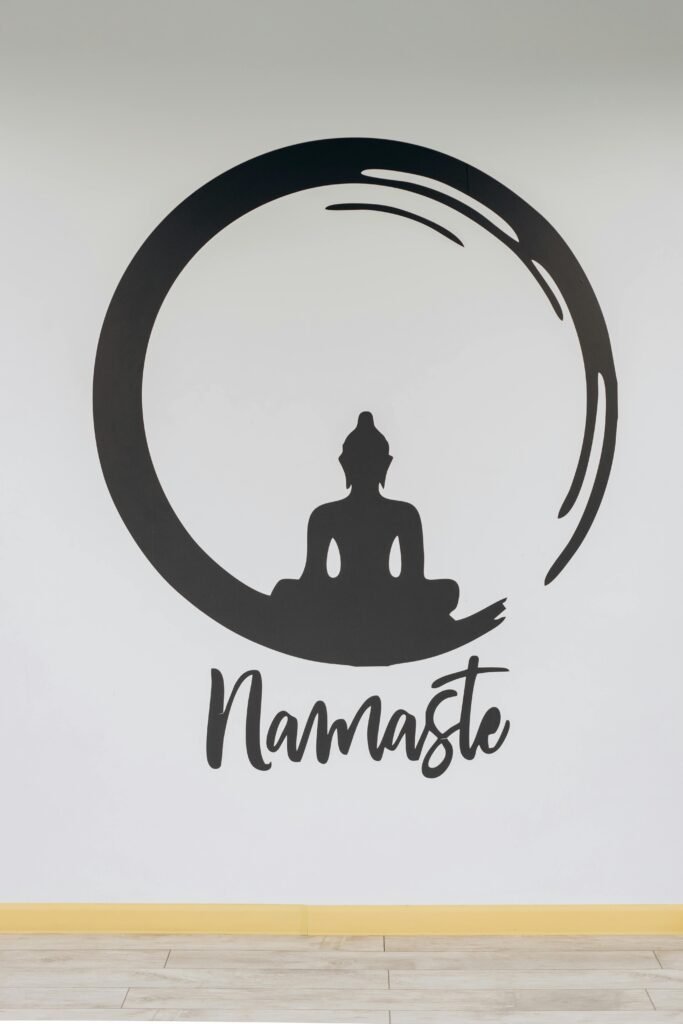
In a world marked by diverse cultures and languages, greetings often serve as the first point of contact between individuals. “Namaste” and “Hello,” two seemingly simple words, embody the diversity of expressions that mark our connections with one another.
While both are used to acknowledge someone’s presence, the cultural and spiritual history behind “Namaste” sets it apart from the casual and commonplace “Hello.”
Namaste
Originating from Sanskrit, “Namaste” is deeply rooted in Sanatana Dharma culture and philosophy.
It is not merely a salutation but a profound gesture that acknowledges the divine within oneself and others. The word itself carries significant spiritual connotations, with “namah” meaning bow, “as” meaning I, and “te” meaning you. Therefore, “Namaste” can be translated as “I bow to you,” signifying a recognition of the divine essence in each individual.
Hello
On the other hand, “Hello” is a universal greeting widely used in various cultures and languages. Its origins are traced back to the 19th century, and it has evolved into a simple and common way to initiate conversation or acknowledge someone’s presence.
Unlike “Namaste,” “Hello” lacks the profound spiritual and cultural associations, making it a more casual and everyday greeting.
While both “Namaste” and “Hello” are expressions used to greet others, the depth of meaning behind “Namaste” extends beyond a mere acknowledgment.
“Namaste” serves as a spiritual and cultural gesture, recognizing the divine within oneself and others, whereas “Hello” remains a straightforward and casual way to initiate communication.
The Spiritual Essence of Namaste

The term “Namaste” finds its roots in ancient Hindu philosophy, particularly in sacred texts like the Rigveda, where it serves as an expression of deep reverence and humility. In the Rigveda, scholars have traced instances where “Namaste” is used to convey a sense of bowing or recognizing the divinity in the person being greeted.
( Please note that Hello carries no such respect or acknowledgement to the divine. It remains as a simple acknowledgement of the bodily presence of another being in the micro-environment of the other being)
This acknowledgment of divinity is further expounded upon in The Upanishads, which explore the profound philosophy that underlies the greeting.
These texts emphasize the concept of Atman, the divine and eternal essence of each individual, which persists across multiple bodies and lifetimes or soul within each individual, reinforcing the idea that “Namaste” is not a mere salutation but a recognition of the sacred within oneself and in others.
The spiritual teachings continue to unfold in the Yoga Sutras of Patanjali, a foundational text of yoga philosophy. Within the Yoga Sutras, the practice of recognizing the divine within oneself and extending that recognition to others aligns closely with the essence of Namaste. This spiritual dimension is further enriched in the Bhagavad Gita, where the concept of recognizing the divine within oneself is intricately woven into the fabric of self-realization and the path to spiritual fulfillment.
In essence, “Namaste” transcends the realm of a conventional greeting, becoming a spiritual practice that fosters a sense of interconnectedness and reverence for the divine essence within all beings.
Namaste has been a term or greeting for centuries. Excavations of Indus Valley Civilizations (which lasted from 3300 BCE to 1300 BCE) uncovered terracotta figurines or small statues in the namaste position (with their hands held in prayer).
In contemporary practices of yoga and spirituality, the word “Namaste” has become a mantra, echoing not just in the physical practice of yoga but also in broader spiritual communities. It serves as a reminder of the deeper meaning of human connection and the shared divine presence that binds individuals together.
The spiritual essence of Namaste extends beyond cultural boundaries, resonating with those who seek a more profound and mindful way of interacting with the world around them. As individuals adopt yoga and mindfulness practices globally, the spiritual depth encapsulated in Namaste continues to inspire a sense of unity and reverence for the sacred within and beyond oneself.
The Evolution of Hello

In stark contrast, the origin of “Hello” is more pragmatic and less rooted in spirituality.
Derived from the Old English greeting “hǣl, meaning good health, its evolution over time has made it a simple and conventional way of initiating conversation. The Merriam-Webster dictionary and the Oxford English Dictionary provide insights into the historical transformation of “Hello” from an expression of good health to a common and neutral greeting.
The Oxford English Dictionary says the first published use of “hello” goes back only to 1826. And it wasn’t mainly a greeting back then. People in the 1830’s said hello to attract attention (“Hello, what do you think you’re doing?”), or to express surprise (“Hello, what have we here?”). Hello didn’t become “hi” until the telephone arrived.
Cultural Reflections in Usage
Comparing the usage of namaste and hello reveals distinctive cultural values and norms. Articles by The Content Authority and The Conversation explore how namaste goes beyond a mere greeting, reflecting a deeper sense of respect and acknowledgment deeply ingrained in Indian culture and beyond.
On the other hand, the universality and simplicity of “Hello” make it a more casual and widely adopted form of greeting across diverse cultures. Makes me wonder how something that simple and carrying very less literal or spiritual association become so popular.
Well!
The Oxford Dictionary says it was Thomas Edison who put hello into common usage. He urged the people who used his phone to say “hello” when answering.
The Tone and Gesture of Respect
Examining the tone and gesture of namaste and hello uncovers nuances in formality and respect.
Learn Religions, wikiHow, and Yoganum offer insights into how the traditional namaste gesture, with palms pressed together and a slight bow, conveys a sense of reverence and formality.
In contrast, the more informal and casual nature of “Hello” is reflected in its use in various settings, often accompanied by a wave or a simple nod.
Namaste and hello are not interchangeable.
They reflect different cultural values and norms. Namaste is more than a greeting, it is a way of showing reverence and recognition of the sacred spark within oneself and others. Hello is a brief and informal way of signaling someone’s existence or starting a dialogue.
Further , although I believe in the divinity inside of the living beings , religions who donot believ in a sikkilar idea might not allow you to use Namaste in your life.
Lets see!
Are you a Christian?
Can you say Namaste to each other?
Well… you can and you should ( considering Covid is still there to stay and many more pandemics are to come , and you donot want to share contact with anyone!) but what does your religion say about it?
Should Christians Say It?

Namaste means “The divine in me bows to the divine in you,”. That can be a person, an animla, a rock, a tree or any inanimate thing.
Namaste might conflict with teachings of Christianity because the Bible teaches that humans are not gods and that humans are only to bow to the one true God, Yahweh.
“I am the LORD; that is my name! I will not yield my glory to another or my praise to idols” (Isaiah 42:8).
“You shall have no other gods before me” (Exodus 20:3).
If you are a Christain you might as well revisit the practice of Namaste as you are placing divinity in your ownself and also in to everyone along with your one true God, Yahweh.
I am fine with everyone using a non-contact greetings where your physical and spiritual energy stays with you only. Putting this into perspective as you might not clearly know what you are doing when you are folding your hands in front of the other to greet them.
Should Muslims Say it?

“Namaste” means ‘ I bow to the divine in you’ which is contrary to the Islamic belief as Namaste seems to imply God resides in us or that God is everywhere or that we are a part of God Himself (nauzubillah) which is against Tawheed.
Tawheed is belief in one God.
Islams advocates Allah is not a part of us nor are we a part of Him. The creator and the creation are different entities.
So as per Islamic scholars saying Namaste is wrong( or Haram).
So if you believe in Islam and never knew this , now you know and now you can make a better choice of either to use Namaste or not in place of Hello.
Namaste is for everyone

The aim of this piece is not to tell people that namaste is not meant for you or for me, aim is to dispell the misconceptions people hve. It is to bring about a better understanding that love and divinity is everywhere.
We acknowledge it by saying Namaste.
We acknowledge that you are special and the kindness in your heart can make the world a better place.
If one seeks to find “it” he/she can find “it” in anything they want. Some find it in books, some in idols, some find it in on mountain tops, some find it in the depths of the oceans.
In considering the possibility that Namaste may not have originally been intended for all, it becomes essential to reflect on the evolving nature of cultural practices.
If Namaste were initially intended for a specific group or community, the broader acceptance and global popularity it has gained suggest a broader resonance.
The evolution of Namaste from its traditional roots to a more inclusive symbol reflects a shared human desire for connection, respect, and understanding. As it traverses cultural and religious borders, Namaste has become a universal gesture, emphasizing our collective humanity.
It is interconnecting people at a divine level where mutual respect and love surpasses all the divergent and divisive teachings of different religions.
In the end, the power of Namaste lies in its ability to bring people together rather than setting them apart.







